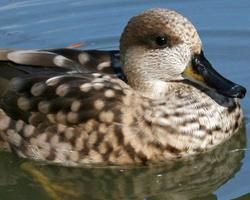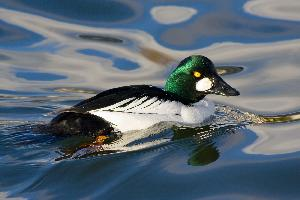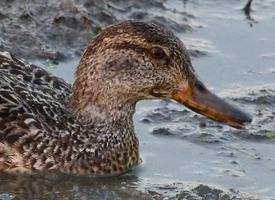
Poids et mesures
| Longueur | de 42 à 49 cm |
|---|---|
| Poids | de 550 à 1300 g |
| Envergure des ailes | de 67 à 75 cm |
Données biologiques
| Durée de vie | 8 r |
|---|
Statut de conservation
| Intrépide |
Description de l'animal
The Common Pochard (Aythya ferina) is a medium-sized diving duck that is widely distributed across much of Eurasia. It is a highly adaptable species that frequents a variety of freshwater habitats, including lakes, marshes, and slow-flowing rivers. The Common Pochard is easily recognizable by its distinctive plumage and physical characteristics, which vary slightly between males and females.Males are particularly striking during the breeding season, with a rich chestnut-red head and neck, a black chest, and a grey back. Their eyes are bright red, adding to their striking appearance. The sides and belly are pale, providing a stark contrast to the darker tones of the upper body. In contrast, females and juveniles are more subdued in color, with brownish bodies and a more uniform appearance. Both sexes, however, share a characteristic grey bill with a black tip, which is a useful identification feature.
The Common Pochard measures approximately 42 to 49 centimeters in length, with a wingspan of 70 to 80 centimeters. It has a compact body, a relatively large head, and a steep forehead, giving it a distinctive silhouette, especially when seen in profile.
As a diving duck, the Common Pochard is well adapted to its aquatic lifestyle. It has powerful legs positioned towards the back of its body, enabling it to dive efficiently for food. Its diet mainly consists of aquatic plants, seeds, and invertebrates, which it often seeks by diving to depths of up to 3 meters. During the breeding season, the diet shifts to include a higher proportion of invertebrates, providing the necessary protein for egg production and chick growth.
Breeding usually occurs in solitary pairs or loose groups. The nest is typically located near water among vegetation, where the female lays a clutch of 8 to 10 eggs. She is solely responsible for incubation, which lasts about 25 to 28 days. The chicks are precocial, meaning they are relatively mature and mobile from the moment of hatching. They are able to feed themselves but remain under the mother's protection until they are ready to fly, about 50 to 60 days later.
The Common Pochard is a migratory species, with birds breeding in northern regions of Europe and Asia and wintering in the warmer southern and western parts of the continent, as well as in parts of Africa and the Indian subcontinent. The migration is a critical time for these birds, as they rely on a network of wetlands along their routes for resting and feeding.
Conservation status of the Common Pochard has become a concern in recent years, with populations declining in parts of its range. The loss and degradation of wetland habitats due to agricultural expansion, urban development, and climate change are significant threats. Additionally, the species is hunted in some areas, which can impact local populations. Conservation efforts are underway in several regions to protect important habitats and manage hunting, aiming to ensure the long-term survival of this beautiful and fascinating duck species.
Animaux similaires
Nouvelles photos d'animaux
Top 10 des animaux
- Dolphin gull (Leucophaeus scoresbii)
- Diana monkey (Cercopithecus diana)
- Moustached guenon (Cercopithecus cephus)
- Galápagos tortoise (Geochelone nigra complex)
- Japanese macaque (Macaca fuscata)
- Russian tortoise (Testudo horsfieldii)
- Stone loach (Barbatula barbatula)
- Greek tortoise (Testudo graeca)
- Common flying dragon (Draco volans)
- Vendace (Coregonus albula)


